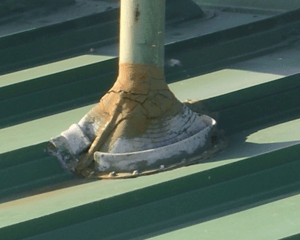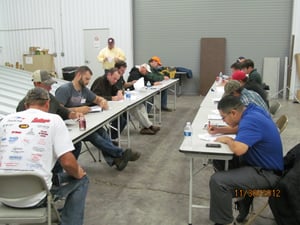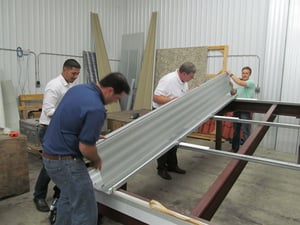5 Benefits of Specifying Manufacturer Certified Installers on Your Projects
Manufacturer certification programs can be a source of confusion. Most often, the confusion stems from using words like “certified,” “approved,” “authorized,” and “qualified” interchangeably. While they may mean the same thing to architects and building owners, those terms often mean completely different things to manufacturers.
For this article, let’s assume that “certification” means an installer has completed system-specific installation training by the panel manufacturer. With that definition established, let's focus on discussing the benefits of requiring a “certified” installer for your next project.
1. Better Quality Installs
 While we all know there are no guarantees in life, using certified installers on your next metal roofing project certainly increases the odds of a better quality installation. For starters, attendees are exposed to the various system components during the certification process. Successful attendees also learn how the roofing system pieces go together and proper installation.
While we all know there are no guarantees in life, using certified installers on your next metal roofing project certainly increases the odds of a better quality installation. For starters, attendees are exposed to the various system components during the certification process. Successful attendees also learn how the roofing system pieces go together and proper installation.
All of that means they aren’t learning the system on your project. And equally important, good training programs also address common errors to avoid. For example, in our certification course at McElroy Metal, we stress things like the importance of monitoring panel modularity and ensuring that pipe boots hit in the flat of a pan instead of hitting at the male/female connection, as shown in the image above. You can imagine how difficult it is to make the pipe boot in the photo watertight.
2. Weathertightness Warranty Requirement
While the expectations vary by manufacturer, it is quite common for manufacturers to require contractor certification for weathertightness warranties. Problems can occur when the specifications don’t require contractor certification, yet it’s a requirement for warranty issuance by the manufacturer. When the installing contractor isn’t “certified,” the manufacturer can refuse to issue the warranty. As you can imagine, this is especially problematic when it’s not identified until after the installation is complete.
Consequently, if you plan to include a weathertightness warranty in your project specifications, the first step should be to determine the warranty type desired. Once that is determined, it’s always best to have a manufacturer’s representative review your plans and specifications before publishing to ensure you’re covered. While that may feel like an extra step to you, it can save untold confusion, missed expectations, and change orders. If we can ever help you in this regard, feel free to contact us!
3. Contractor Commitment
While becoming a manufacturer-certified installer isn’t an impossible process, there are most certainly hard and soft costs involved. The hard costs include things like course registration fees and travel expenses. But in the tight labor market, the soft cost of taking one or two key crew members out of the field for a couple of days is often the more significant of the two costs.
Consequently, becoming a certified installer typically means the contractor is committing to the trade of installing metal roofing and learning the proper techniques. It’s important to note that they are also committing to a partnership with the manufacturer. Those types of commitments typically indicate professionalism and a desire for craftsmanship, leading to higher quality installs.
4. Manufacturer Contact
Wouldn’t it be nice if you could “phone a friend” for questions that come up during installation? While not guaranteed, there’s a good chance that working with a certified installer means just that. The folks who teach the certification classes present a wealth of knowledge, and by spending time together through the certification process, relationships between the manufacturer and class attendees routinely develop. And perhaps most importantly, contact information is usually also exchanged.
The trainers can often be a great source for product-related questions once crews are on the job site. Additionally, due to the time the trainers have spent on job sites themselves, they are well-suited to offer insight. Over time, they have seen unique conditions you can only imagine, identified problems and solutions, and developed best practices. All of that means that when someone on the project team (architect, contractor, or superintendent) has a question, you’ll likely have an existing relationship with an expert when you work with a certified installer.
5. Quicker Install
The chances are good that every owner you work with wants their project finished on the project schedule, if not before. In a perfect world, that’s a reasonable expectation. But we all know that construction is a messy business. Delays occur on materials from other trades, mistakes and re-work happen, and schedules often fall by the wayside early in the project. While requiring contractor certification can’t work miracles with your project schedule, certified installer crews routinely install products quicker than their non-certified counterparts.
It’s not that contractors who aren’t certified are bad, but they often lack familiarity with manufacturers’ specific products, parts, and pieces. So instead of taking time to learn the system on your project and your schedule, certified installers arrive at the site with the experience that allows them to reduce the install time and get your projects done more quickly.
Key Considerations for Requiring Manufacturer Certification
While the benefits of manufacturer certification are numerous, there are some key considerations when including this requirement in your project specifications.
 Programs Differ. While the term manufacturer certification is used interchangeably through the metal roof and wall panel industry, certification programs vary widely between manufacturers. Some manufacturers conduct their programs in a conference room at a local hotel where participants are taught only through PowerPoint or by reviewing install manuals for one or two hours.
Programs Differ. While the term manufacturer certification is used interchangeably through the metal roof and wall panel industry, certification programs vary widely between manufacturers. Some manufacturers conduct their programs in a conference room at a local hotel where participants are taught only through PowerPoint or by reviewing install manuals for one or two hours.
Other programs are much more robust lasting 1-2 days and include contractors physically working with tools, panels, and accessories to learn hands-on how to install the product properly. Additionally, the more robust programs typically require attendees to take and pass an exam after the training, where a passing score is usually necessary to obtain certification.
 At McElroy Metal, we’re proud to offer one of the most robust programs in the industry. Our program includes both classroom and hands-on training where contractors install panels under the guidance of our instructors.
At McElroy Metal, we’re proud to offer one of the most robust programs in the industry. Our program includes both classroom and hands-on training where contractors install panels under the guidance of our instructors.
In fact, our instructors also frequently perform our weathertightness warranty inspections. We can’t think of a better way to ensure your next project uses proper details critical to the building envelope.
Lastly, some manufacturers also include basic credit checks as a part of their certification processes. While the approach varies, manufacturers often look at how long a company has been in business, payment history, and an asset to debt ratio to ensure financial strength as part of their certification process. Some manufacturers also research the contractor to ensure there isn’t any open litigation pending.
Bidders Can Be Limited. While requiring contractor certification can help ensure the benefits previously discussed, it’s important to understand that it does so by limiting the installers that can bid on your project. When a contractor isn’t already certified by a manufacturer, they can experience two hurdles:
- They may be able to get certified but can’t do so within the time frame the project requires.
- They simply may not be able to meet the manufacturer’s specified criteria.
Consequently, contractors may want to bid on your project but won’t be allowed because they don’t meet the certified installer criteria. Admittedly, this can sometimes be frustrating during the bidding process, but it’s important to remember the benefits you hoped to gain by setting the certification expectation initially.
Know Who is Certified. While there are some variations, most manufacturers certify the individual who attended the training program instead of the company that employs them. While that approach is a slight nuance, it is important and often overlooked.
Consider these examples:
- Bob, a long-time superintendent for ABC Roofing, attends our certification program and passes all requirements. But a few months later, in a tight labor market, DEF Roofing steals him away to work for them. The remaining crew at ABC Roofing may (or may not, in many cases) be familiar with our system. Consequently, we can no longer indicate that ABC Roofing is a certified contractor with McElroy Metal.
- Bob, a long-time superintendent for ABC Roofing, attends our certification program and passes all requirements. You publish a specification that requires a certified installer, but Bob is working on a project across town, so another foreman at ABC Roofing, Jack, handles the install. Since Jack didn’t complete our certification process, we have no way of knowing his skillset or familiarity with our systems and consequently can’t certify him as a McElroy Metal installer.
Bottom line: If you’re going to the trouble to require contractor certification in your project specifications, don’t forget to require that the General Contractor monitors during construction to ensure that the actual crew on the roof is certified by the manufacturer. Without this step, there may be a noticeable gap between what you “think” you’re getting and what you are regarding installer certification.
Certification Expires: Once achieved, manufacturer certification typically lasts for a limited time frame. Once the established time passes, contractors are required to complete a recertification process. This process also varies widely by the manufacturer and is often impacted by the contractor’s quantity and quality of work during their initial certification window.
From the architect’s perspective, it’s most important to understand that certifications can (and do!) expire. Someone who may have previously been certified with a manufacturer may no longer hold that designation. Consequently, if installer certification is important to you, it’s imperative that a copy of the contractor certification be a requirement in the submittal package.
In summary, requiring a certified installer on your next standing seam project offers a host of benefits, including the potential for higher quality and quicker installs. But there are also some nuances that bear consideration.
If you’d like to chat more about the pros and cons of including this requirement for your next project specification, contact us, we’re here to help!
About McElroy Metal
Since 1963, McElroy Metal has served the construction industry with quality products and excellent customer service. The employee-owned components manufacturer is headquartered in Bossier City, La., and has 14 manufacturing facilities across the United States. Quality, service and performance have been the cornerstone of McElroy Metal’s business philosophy and have contributed to the success of the company through the years. As a preferred service provider, these values will continue to be at the forefront of McElroy Metal’s model along with a strong focus on the customer.





.png?width=767&name=Metal%20Roofing%20for%20Event%20Centers,%20Arenas%20%20&%20Sports%20Facilities%20(1).png)



Comments on this article:
Scroll down to the bottom to submit a comment and join the conversation. Need help or have a question? Please contact us. Looking for a distributor or contractor? Please click here to get started.